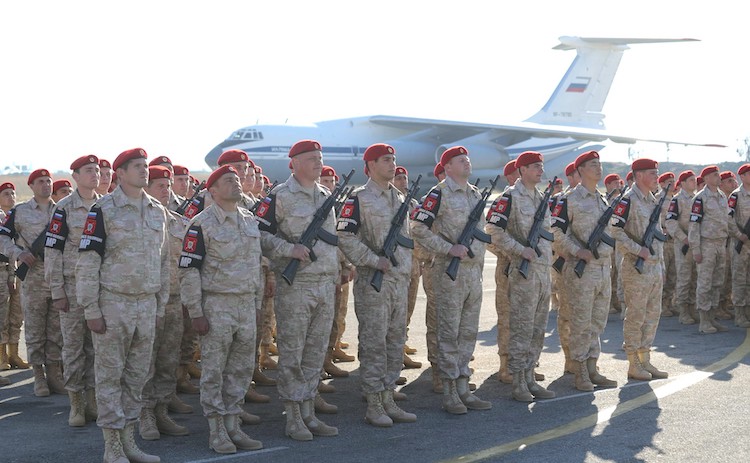The Trump administration’s recent decision to move U.S. troops out of Syria, effectively abandoning the Kurdish fighters, Washington’s long-term military partners in the region, sent ripples across the world. While the White House was slammed in the media for the move—largely seen as a major betrayal of an ally, the news was met favorably in Turkey and Russia. Moscow is playing a long game in the Middle East and moving to fill the power vacuum.

Russian troops at the Khmeimim Air Base in Syria currently operated by Russia. Photo: kremlin.ru
When Russian involvement in Syria began four years ago, the West hoped that Vladimir Putin would sink into the Syrian quagmire and temper Tehran’s influence in the country. However, these expectations have not come true. In fact, Russia has become the strongest player in Syria and continues to impose its policies on the rest of the Middle East.
The decision to interfere with Syria was made in Moscow only in late 2015, when the rise of ISIS posed too great a threat to Russia for it to remain an idle observer. Bashar al-Assad's regime was in jeopardy, the United States failed to deter ISIS, and the influx of volunteer jihadists from Russia’s North Caucasus and former Soviet republics to Syria intensified. The result could have been a Sunni jihadist takeover of Syria, sending a wave of terror across Russia.
Coming to Assad’s rescue, Putin saw the Syrian involvement as a golden opportunity to elevate his status in the Middle East and around the world. Russian Middle East experts claim that Russia never left the region, but in fact, by 2011, Moscow's footprint there was extremely limited. In Syria, Russian leaders managed to make the best out of the unraveling crisis: they provided a lifeline to the Assad regime, expanded their presence on Syrian soil, engaged with each and every actor involved in Syria, and positioned Russia as the only strong force with “boots on the ground.” Russia’s vigorous activity has also been a kind of defiance against the lack of a clear U.S. strategy and the inability of European countries to end the Syrian civil war.
In five years, Russia has established close ties with all the major players in the region—not just Assad, Hezbollah, and Iran, but also Ankara, Jerusalem, Beirut, and Riyadh, which credit Russia for helping them remain on the Syrian chessboard.
Apart from geopolitical gains, Syrian involvement gave Russia a chance to test its latest state-of-the-art weapons in its first expansive military operation on foreign soil since the collapse of the Soviet Union. The Russian government is already reaping the benefits through arms sales to Recep Erdogan, Abd al-Fattah al-Sisi, and others, setting up nuclear power plants in Egypt, Jordan, and Algeria, assisting failed states, such as Sudan, and, no doubt, finding new markets for Russian oil and gas.
Still, not everyone is ready to fall into the Russian president’s arms, and the Gulf states, as well as Egypt, continue to lean on the United States, for now. But Washington’s lack of clarity regarding many regional issues certainly plays into the Kremlin’s hands: unlike the U.S., Russia has long-term plans in the region.
Syria is just the first stop on Russia's long road to the heart of the Middle East. Today, Russia’s S-300 air defense system already covers Syrian and Lebanese territories, while Iraq is negotiating to purchase the system as well. In the meantime, Israel finds itself in a difficult position. While Prime Minister Benjamin Netanyahu finessed an arrangement with the Russians to prevent collisions in Syria's skies, this is not a strategic alliance. Moreover, Netanyahu’s hopes that Russia would push Iran away from Syria never materialized, and neither did his expectations of driving a wedge between Moscow and Tehran. Despite all the differences, the Russian-Iranian alliance is growing stronger, as evidenced by Iranian plans to hold a large-scale military exercise with Russian troops.
As the United States withdraws from the region both physically (abandoning its Kurdish allies in Northern Syria) and politically (implying that the region has lost its strategic and economic importance), the vacuum of power will inevitably be filled by another superpower, that is, Russia. It will not happen overnight despite the massive arms sales and billion-dollar deals, such as the recent agreements signed between Moscow and Saudi Arabia.
However, Moscow is playing a long game in the Middle East, looking for opportunities to advance its geopolitical standing in the world. Russia has an advantage in the Middle East as it has no ideological preferences or constraints that come with established allies.While Israel looks pragmatically at relations with Russia to avoid conflicts with Moscow in Syrian skies and to address its security concerns in Syria, those U.S. policymakers who still believe in the U.S.-led international order need to take a closer look at the changing political landscape of the Middle East and re-examine America’s role in this region.
Ksenia Svetlova is a Senior Research Fellow at the Institute for Policy and Strategy, IDC Herzliya, and a former member of the Knesset. This article first appeared on YNet; the English translation was edited for clarity.

